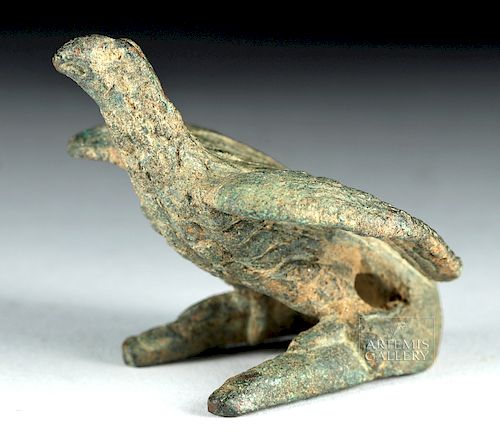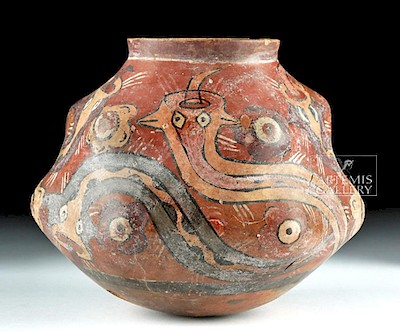Roman Bronze Figurine of a Standing Eagle
Lot 39g
About Seller
Artemis Gallery
686 S Taylor Ave, Ste 106
Louisville, CO 80027
United States
Selling antiquities, ancient and ethnographic art online since 1993, Artemis Gallery specializes in Classical Antiquities (Egyptian, Greek, Roman, Near Eastern), Asian, Pre-Columbian, African / Tribal / Oceanographic art. Our extensive inventory includes pottery, stone, metal, wood, glass and textil...Read more
Categories
Estimate:
$600 - $900
Absentee vs Live bid
Two ways to bid:
- Leave a max absentee bid and the platform will bid on your behalf up to your maximum bid during the live auction.
- Bid live during the auction and your bids will be submitted real-time to the auctioneer.
Bid Increments
| Price | Bid Increment |
|---|---|
| $0 | $25 |
| $300 | $50 |
| $1,000 | $100 |
| $2,000 | $250 |
| $5,000 | $500 |
| $10,000 | $1,000 |
| $20,000 | $2,500 |
| $50,000 | $5,000 |
| $100,000 | $10,000 |
| $200,000 | $20,000 |
About Auction
By Artemis Gallery
Jul 5, 2018
Set Reminder
2018-07-05 10:00:00
2018-07-05 10:00:00
America/New_York
Bidsquare
Bidsquare : Ancient | Ethnographic | Fine Art
https://www.bidsquare.com/auctions/artemis-gallery/ancient-ethnographic-fine-art-3306
Featuring classical antiquities, ancient and ethnographic art from cultures encompassing the globe. Artemis Gallery info@artemisgallery.com
Featuring classical antiquities, ancient and ethnographic art from cultures encompassing the globe. Artemis Gallery info@artemisgallery.com
- Lot Description
Roman, Imperial Period, ca. 1st to 2nd century CE. A beautiful cast-bronze figurine of a standing eagle with its raised head turned slightly to its left, with meticulous feather detailing on the head, chest, and flowing wings emphasizing its naturalistic qualities. The eagle stands atop a pair of narrow, clawed feet with bent legs, almost as if it were ready to take flight at a moment's notice. The turned head displays teardrop-form eyes, a planar brow, a petite incised mouth, and an intimidating aquiline beak. The eagle's feet are attached to a curved finial with a deep groove on its underside. Size: 2.25" L x 1.9" W x 1.7" H (5.7 cm x 4.8 cm x 4.3 cm)
The eagle was a highly-symbolic animal among the Roman military and was a great symbol of pride and victory in the eyes of the legions. Known as "aquila" in Latin, the eagle was a representation of honor, victory, and cohesiveness within a legion. One member of each legion was referred to as an aquilifer, or "eagle-bearer," as it was their primary duty to carry and protect that legion's designated eagle standard. If ever an aquila was lost or stolen, it was the primary obligation of the aquilifer to go to any lengths to recover the standard and see to its safe return. Losing an eagle standard was considered a grave omen for its respective legion and would typically lead to distrust and paranoia among the legionaries. To quote a piece of historical fiction set in Roman Britain entitled The Eagle of the Ninth (Rosemary Sutcliff, 1954), "Eagle lost, honor lost; honor lost, all lost."
Provenance: private East Coast, USA collection
All items legal to buy/sell under U.S. Statute covering cultural patrimony Code 2600, CHAPTER 14, and are guaranteed to be as described or your money back.
A Certificate of Authenticity will accompany all winning bids.
We ship worldwide and handle all shipping in-house for your convenience.
#132436Pale green patina on surface with very light surface encrustation.Condition
- Shipping Info
-
All shipping is handled in-house for your convenience. Your invoice from Artemis Gallery will include shipping calculation instructions. If in doubt, please inquire BEFORE bidding for estimated shipping costs for individual items.
-
- Buyer's Premium



 EUR
EUR CAD
CAD AUD
AUD GBP
GBP MXN
MXN HKD
HKD CNY
CNY MYR
MYR SEK
SEK SGD
SGD CHF
CHF THB
THB
















